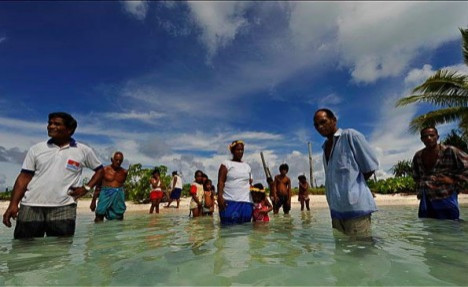Australia Faces Wave Of 'Climate Refugees' From Small Island Nations

Australia’s main coalition of refugee advocacy groups has urged the government to prepare for an impending wave of people fleeing neighboring small island nations in the Pacific Ocean due to climate change-driven sea level rise.
Phil Glendenning, the head of the Refugee Council of Australia, recently said that the government should expand its definition of refugees to include people affected by climate change and offer the same protections it provides to those fleeing conflict or political oppression.
Canberra’s current definition is based on the United Nations 1951 Convention relating to the Status of Refugees, a legal document that does not currently recognize so-called “climate change refugees.”
"These are people who are not suffering from persecution because of their beliefs, race or because they belong to a particular group. So they don't meet the Refugee Convention criteria but, nevertheless, there will be a need for people to be resettled, because they have been displaced by climate change," Glendenning said, according to the Guardian.
"This is a new cohort of people who are emerging; the rest of the world needs to pay attention," he added.
Glendenning’s statements follow the high-profile case of a man from the small island nation of Kiribati who was denied refugee status in New Zealand last year after he argued that climate change would cause sea levels to rise and submerge his country, which stands only 10 feet (3 meters) above sea level at its highest point.
The government of Kiribati is seeking to relocate the island’s population of about 100,000 people and has requested that Australia and New Zealand accept them as refugees, but neither Canberra nor Wellington have made any offers.
Nevertheless, Australia’s Foreign Ministry has acknowledged that scientific evidence indicates that Kiribati will become uninhabitable in less than two decades if sea levels continue to rise.
“Kiribati is at the front line of climate change," Foreign Minister Bob Carr said in February. "Unless action is taken, Kiribati will be uninhabitable by 2030 as a result of coastal erosion, sea level rise and saltwater intrusion into drinking water."
According to the Australian Bureau of Meteorology’s latest South Pacific and Climate Monitoring Project report, the sea level around Kiribati has risen by 0.12 inches (3.1 millimeters) per year since 1992.
Similar increases have been documented around other small island nations in the South Pacific with slight variations due to “atmospheric, oceanographic and geological processes,” according to the report.
The vast body of scientific research on climate change indicates that rising sea levels are attributable to the heat expansion of ocean waters and the melting of glaciers and polar ice caps as average global temperatures rise due to the buildup of greenhouse gases in the atmosphere generated by human activity, such as the mass consumption of fossil fuels and deforestation.
© Copyright IBTimes 2024. All rights reserved.











